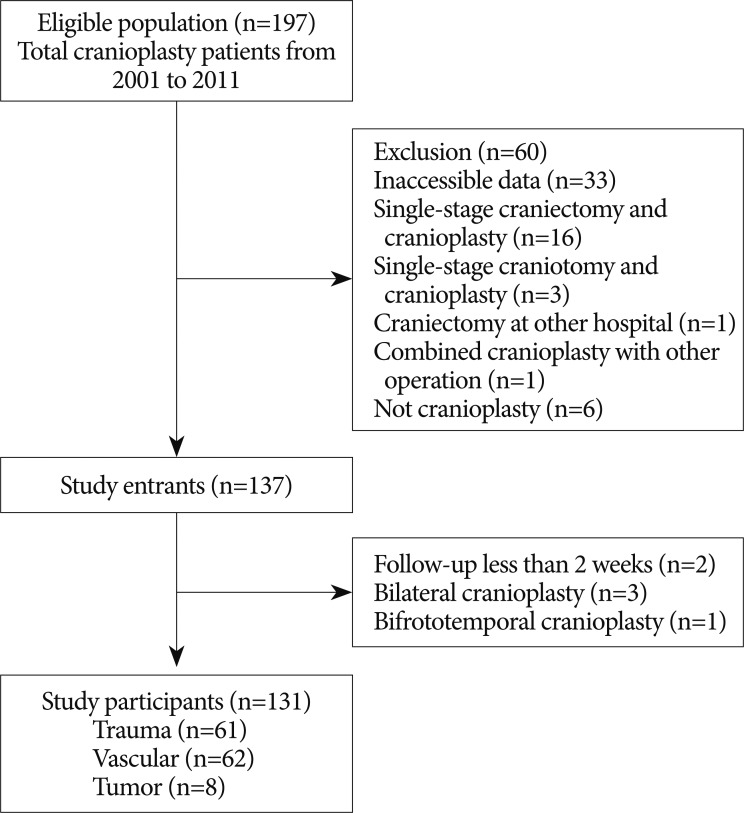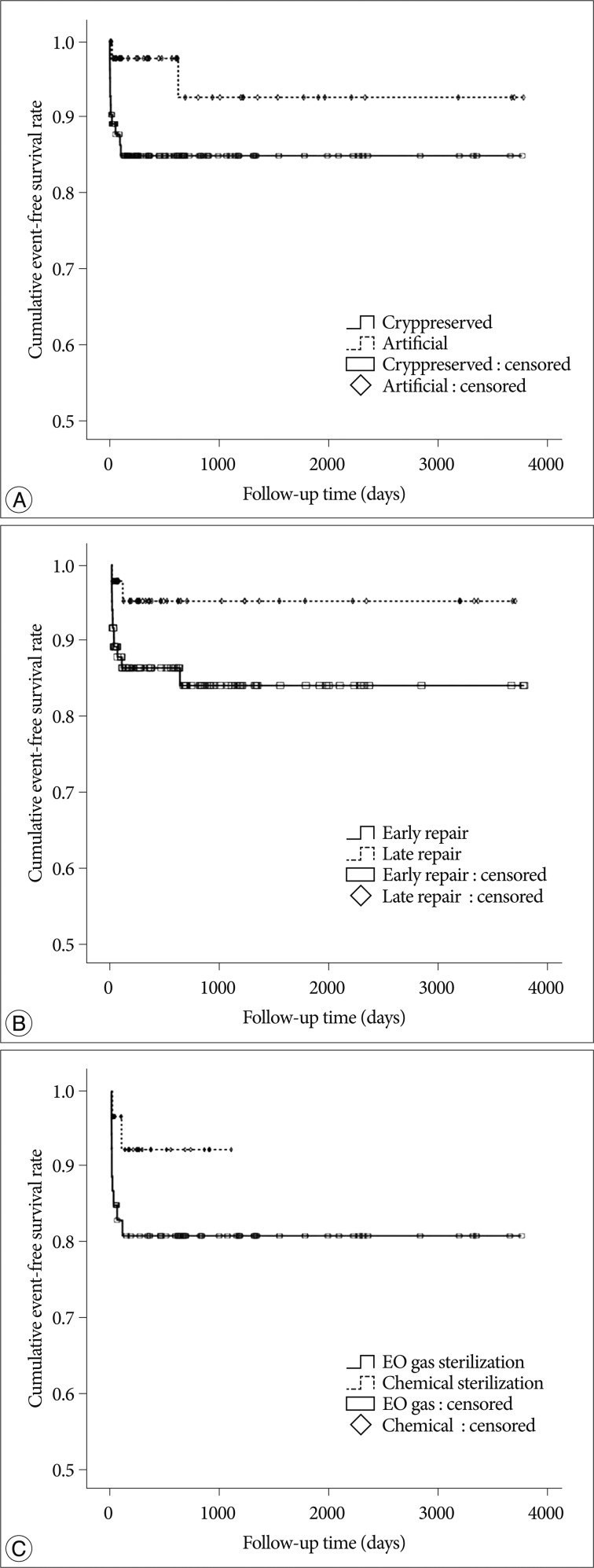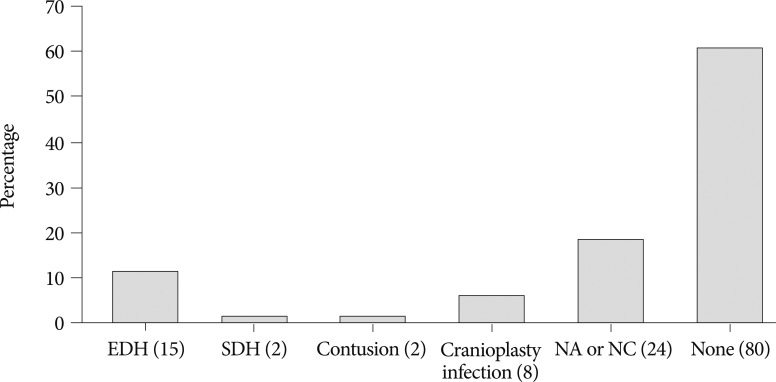Long-Term Incidence and Predicting Factors of Cranioplasty Infection after Decompressive Craniectomy
- Affiliations
-
- 1Department of Neurosurgery, Incheon St. Mary's Hospital, The Catholic University of Korea College of Medicine, Incheon, Korea. argus3620@gmail.com
- KMID: 2190659
- DOI: http://doi.org/10.3340/jkns.2012.52.4.396
Abstract
OBJECTIVE
The predictors of cranioplasty infection after decompressive craniectomy have not yet been fully characterized. The objective of the current study was to compare the long-term incidences of surgical site infection according to the graft material and cranioplasty timing after craniectomy, and to determine the associated factors of cranioplasty infection.
METHODS
A retrospective cohort study was conducted to assess graft infection in patients who underwent cranioplasty after decompressive craniectomy between 2001 and 2011 at a single-center. From a total of 197 eligible patients, 131 patients undergoing 134 cranioplasties were assessed for event-free survival according to graft material and cranioplasty timing after craniectomy. Kaplan-Meier survival analysis and Cox regression methods were employed, with cranioplasty infection identified as the primary outcome. Secondary outcomes were also evaluated, including autogenous bone resorption, epidural hematoma, subdural hematoma and brain contusion.
RESULTS
The median follow-up duration was 454 days (range 10 to 3900 days), during which 14 (10.7%) patients suffered cranioplasty infection. There was no significant difference between the two groups for event-free survival rate for cranioplasty infection with either a cryopreserved or artificial bone graft (p=0.074). Intergroup differences according to cranioplasty time after craniectomy were also not observed (p=0.083). Poor neurologic outcome at cranioplasty significantly affected the development of cranioplasty infection (hazard ratio 5.203, 95% CI 1.075 to 25.193, p=0.04).
CONCLUSION
Neurologic status may influence cranioplasty infection after decompressive craniectomy. A further prospective study about predictors of cranioplasty infection including graft material and cranioplasty timing is necessary.
Keyword
MeSH Terms
Figure
Cited by 5 articles
-
Bone Flap Resorption Following Cranioplasty after Decompressive Craniectomy: Preliminary Report
Ji Sang Kim, Jin Hwan Cheong, Je Il Ryu, Jae Min Kim, Choong Hyun Kim
Korean J Neurotrauma. 2015;11(1):1-5. doi: 10.13004/kjnt.2015.11.1.1.Prophylactic Effect of Vancomycin on Infection after Cranioplasty in Methicillin-Resistant
Staphylococcus Aureus Carriers with Traumatic Brain Injury
Jin Hyuk Bang, Keun-Tae Cho, Seong Yeon Park
Korean J Neurotrauma. 2015;11(2):81-86. doi: 10.13004/kjnt.2015.11.2.81.Analyses Using Micro-CT Scans and Tissue Staining on New Bone Formation and Bone Fusion According to the Timing of Cranioplasty via Frozen Autologous Bone Flaps in Rabbits : A Preliminary Report
Hee Sup Shin, Deok-Won Lee, Seung Hwan Lee, Jun Seok Koh
J Korean Neurosurg Soc. 2015;57(4):242-249. doi: 10.3340/jkns.2015.57.4.242.Which One Is Better to Reduce the Infection Rate, Early or Late Cranioplasty?
Jae-Sang Oh, Kyeong-Seok Lee, Jai-Joon Shim, Seok-Mann Yoon, Jae-Won Doh, Hack-Gun Bae
J Korean Neurosurg Soc. 2016;59(5):492-497. doi: 10.3340/jkns.2016.59.5.492.Bone Flap Resorption Following Cranioplasty with Autologous Bone: Quantitative Measurement of Bone Flap Resorption and Predictive Factors
Sang Pil Park, Jae Hoon Kim, Hee In Kang, Deok Ryeong Kim, Byung Gwan Moon, Joo Seung Kim
J Korean Neurosurg Soc. 2017;60(6):749-754. doi: 10.3340/jkns.2017.0203.002.
Reference
-
1. Aarabi B, Hesdorffer DC, Ahn ES, Aresco C, Scalea TM, Eisenberg HM. Outcome following decompressive craniectomy for malignant swelling due to severe head injury. J Neurosurg. 2006; 104:469–479. PMID: 16619648.
Article2. Asano Y, Ryuke Y, Hasuo M, Simosawa S. [Cranioplasty using cryopreserved autogenous bone]. No To Shinkei. 1993; 45:1145–1150. PMID: 8123304.3. Chang V, Hartzfeld P, Langlois M, Mahmood A, Seyfried D. Outcomes of cranial repair after craniectomy. J Neurosurg. 2010; 112:1120–1124. PMID: 19612971.
Article4. Cheng YK, Weng HH, Yang JT, Lee MH, Wang TC, Chang CN. Factors affecting graft infection after cranioplasty. J Clin Neurosci. 2008; 15:1115–1119. PMID: 18656363.
Article5. Dujovny M, Aviles A, Agner C, Fernandez P, Charbel FT. Cranioplasty : cosmetic or therapeutic? Surg Neurol. 1997; 47:238–241. PMID: 9068693.6. Fiorot JA Jr, Silva GS, Cavalheiro S, Massaro AR. Use of decompressive craniectomy in the treatment of hemispheric infarction. Arq Neuropsiquiatr. 2008; 66:204–208. PMID: 18545783.
Article7. Gooch MR, Gin GE, Kenning TJ, German JW. Complications of cranioplasty following decompressive craniectomy : analysis of 62 cases. Neurosurg Focus. 2009; 26:E9. PMID: 19485722.8. Honeybul S, Ho KM. Long-term complications of decompressive craniectomy for head injury. J Neurotrauma. 2011; 28:929–935. PMID: 21091342.
Article9. Huang YH, Yang TM, Lee TC, Chen WF, Yang KY. Acute autologous bone flap infection after cranioplasty for postinjury decompressive craniectomy. Injury. 2011; [Epub ahead of print].
Article10. Inamasu J, Kuramae T, Nakatsukasa M. Does difference in the storage method of bone flaps after decompressive craniectomy affect the incidence of surgical site infection after cranioplasty? Comparison between subcutaneous pocket and cryopreservation. J Trauma. 2010; 68:183–187. discussion 187. PMID: 20065773.
Article11. Iwama T, Yamada J, Imai S, Shinoda J, Funakoshi T, Sakai N. The use of frozen autogenous bone flaps in delayed cranioplasty revisited. Neurosurgery. 2003; 52:591–596. discussion 595-596. PMID: 12590683.
Article12. Jho DH, Neckrysh S, Hardman J, Charbel FT, Amin-Hanjani S. Ethylene oxide gas sterilization : a simple technique for storing explanted skull bone. Technical note. J Neurosurg. 2007; 107:440–445. PMID: 17695404.
Article13. Kim YW, Yoo DS, Kim DS, Huh PW, Cho KS, Kim JG, et al. The infection rate in case of cranioplasty according to used materials and skull defect duration. J Korean Neurosurg Soc. 2001; 30:S216–S220.14. Lee SC, Wu CT, Lee ST, Chen PJ. Cranioplasty using polymethyl methacrylate prostheses. J Clin Neurosci. 2009; 16:56–63. PMID: 19046734.
Article15. Matsuno A, Tanaka H, Iwamuro H, Takanashi S, Miyawaki S, Nakashima M, et al. Analyses of the factors influencing bone graft infection after delayed cranioplasty. Acta Neurochir (Wien). 2006; 148:535–540. discussion 540. PMID: 16467959.
Article16. Murthy JM, Chowdary GV, Murthy TV, Bhasha PS, Naryanan TJ. Decompressive craniectomy with clot evacuation in large hemispheric hypertensive intracerebral hemorrhage. Neurocrit Care. 2005; 2:258–262. PMID: 16159072.
Article17. Nagayama K, Yoshikawa G, Somekawa K, Kohno M, Segawa H, Sano K, et al. [Cranioplasty using the patient's autogenous bone preserved by freezing--an examination of post-operative infection rates]. No Shinkei Geka. 2002; 30:165–169. PMID: 11857940.18. Otani N, Takasato Y, Masaoka H, Hayakawa T, Yoshino Y, Yatsushige H, et al. Surgical outcome following decompressive craniectomy for poor-grade aneurysmal subarachnoid hemorrhage in patients with associated massive intracerebral or Sylvian hematomas. Cerebrovasc Dis. 2008; 26:612–617. PMID: 18946217.
Article19. Patir R, Mahapatra AK, Banerji AK. Risk factors in postoperative neurosurgical infection. A prospective study. Acta Neurochir (Wien). 1992; 119:80–84. PMID: 1481758.20. Qiu W, Guo C, Shen H, Chen K, Wen L, Huang H, et al. Effects of unilateral decompressive craniectomy on patients with unilateral acute post-traumatic brain swelling after severe traumatic brain injury. Crit Care. 2009; 13:R185. PMID: 19930556.
Article21. Shoakazemi A, Flannery T, McConnell RS. Long-term outcome of subcutaneously preserved autologous cranioplasty. Neurosurgery. 2009; 65:505–510. discussion 510. PMID: 19687696.
Article22. Thavarajah D, De Lacy P, Hussien A, Sugar A. The minimum time for cranioplasty insertion from craniectomy is six months to reduce risk of infection--a case series of 82 patients. Br J Neurosurg. 2012; 26:78–80. PMID: 21973063.
Article23. Yadla S, Campbell PG, Chitale R, Maltenfort MG, Jabbour P, Sharan AD. Effect of early surgery, material, and method of flap preservation on cranioplasty infections : a systematic review. Neurosurgery. 2011; 68:1124–1129. discussion 1130. PMID: 21242830.
- Full Text Links
- Actions
-
Cited
- CITED
-
- Close
- Share
- Similar articles
-
- Analysis of the Risk Factors Affecting the Surgical Site Infection after Cranioplasty Following Decompressive Craniectomy
- Complications of Cranioplasty Following Decompressive Craniectomy: Risk Factors of Complications and Comparison Between Autogenous and Artificial Bones
- Review of Cranioplasty after Decompressive Craniectomy
- Paradoxical Herniation after Decompressive Craniectomy for Acute Subdural Hematoma
- Bone Flap Resorption Following Cranioplasty after Decompressive Craniectomy: Preliminary Report




